Kaffeine: Evaluating Business Feasibility in Nepal's Coffee Industry
VerifiedAdded on 2022/08/27
|5
|933
|22
Case Study
AI Summary
This case study analyzes the potential of Kaffeine, a proposed coffee shop venture, in the rapidly growing coffee market of Kathmandu, Nepal. The analysis begins with an assessment of the market using Porter's Five Forces, highlighting the threats and opportunities. It then examines Kaffeine's target market, pricing strategy, and main competitor, Himalayan Java Coffee. Financial projections, including depreciation methods and payback periods, are evaluated. The study concludes with a recommendation for the entrepreneurs to proceed with the business, emphasizing the long-term potential. Furthermore, it offers recommendations for Kaffeine to differentiate its products and target its business segment effectively. The case study provides a comprehensive overview of the key considerations for launching a coffee shop in the Nepalese market.
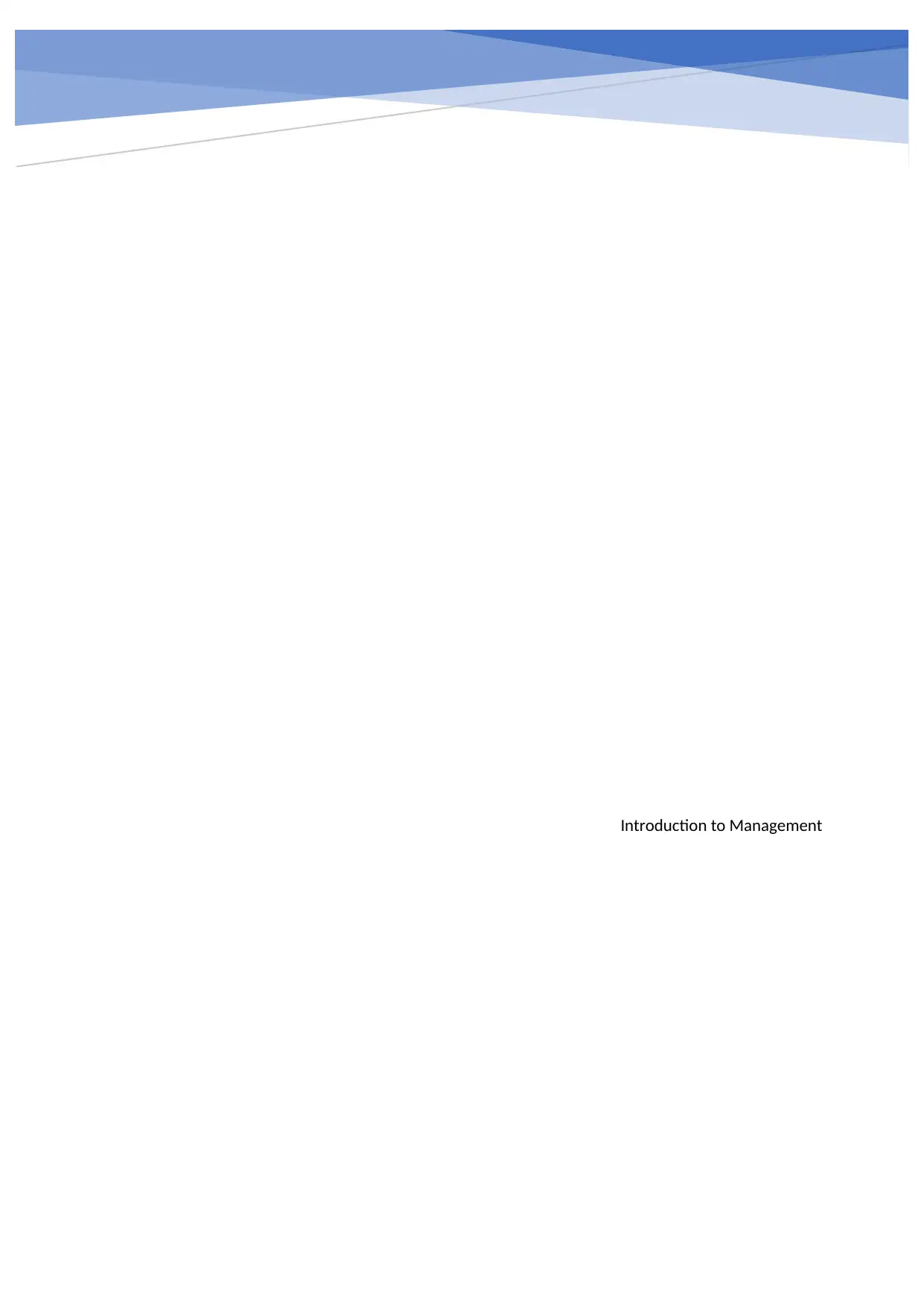
Introduction to Management
Paraphrase This Document
Need a fresh take? Get an instant paraphrase of this document with our AI Paraphraser
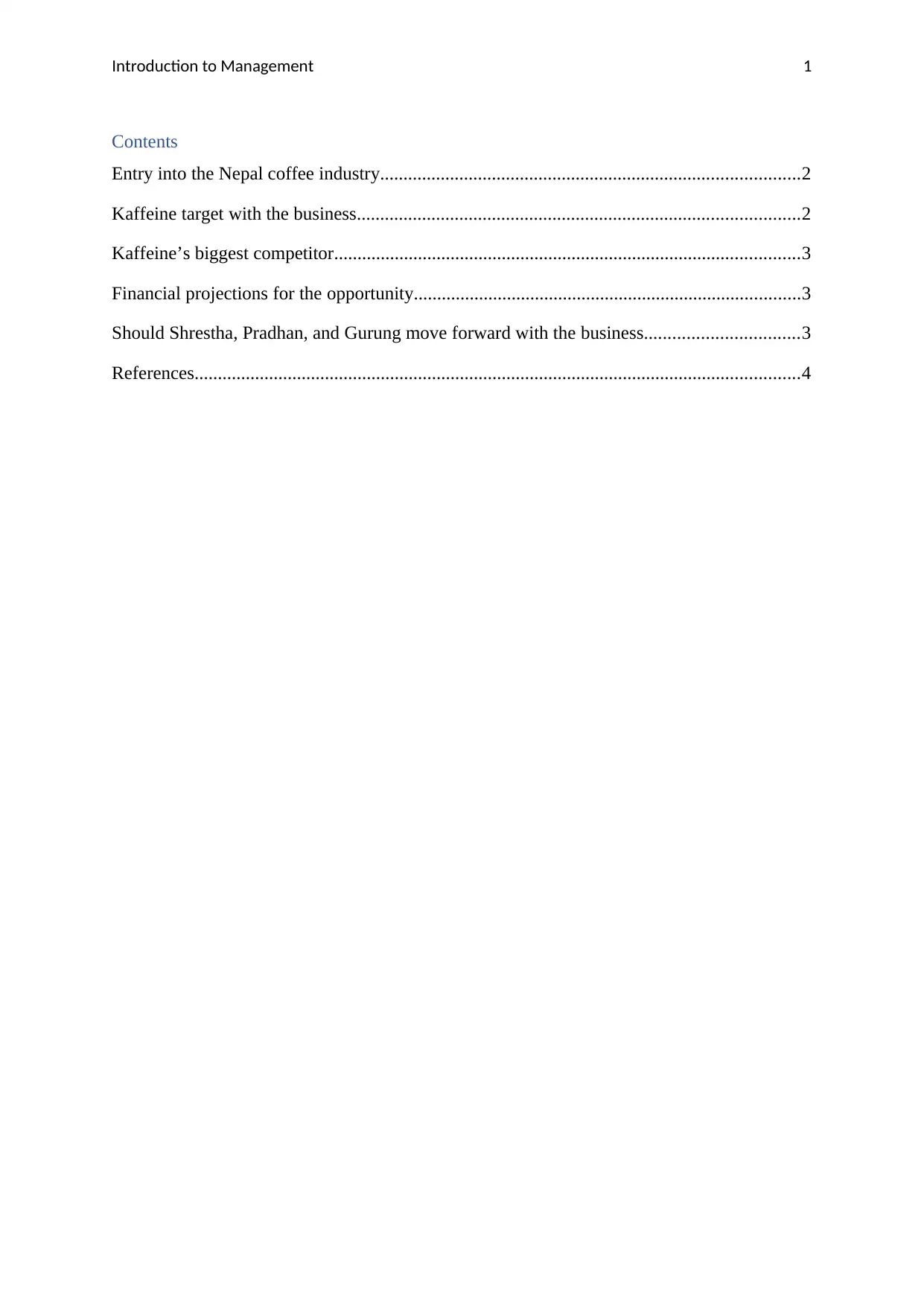
Introduction to Management 1
Contents
Entry into the Nepal coffee industry..........................................................................................2
Kaffeine target with the business...............................................................................................2
Kaffeine’s biggest competitor....................................................................................................3
Financial projections for the opportunity...................................................................................3
Should Shrestha, Pradhan, and Gurung move forward with the business.................................3
References..................................................................................................................................4
Contents
Entry into the Nepal coffee industry..........................................................................................2
Kaffeine target with the business...............................................................................................2
Kaffeine’s biggest competitor....................................................................................................3
Financial projections for the opportunity...................................................................................3
Should Shrestha, Pradhan, and Gurung move forward with the business.................................3
References..................................................................................................................................4
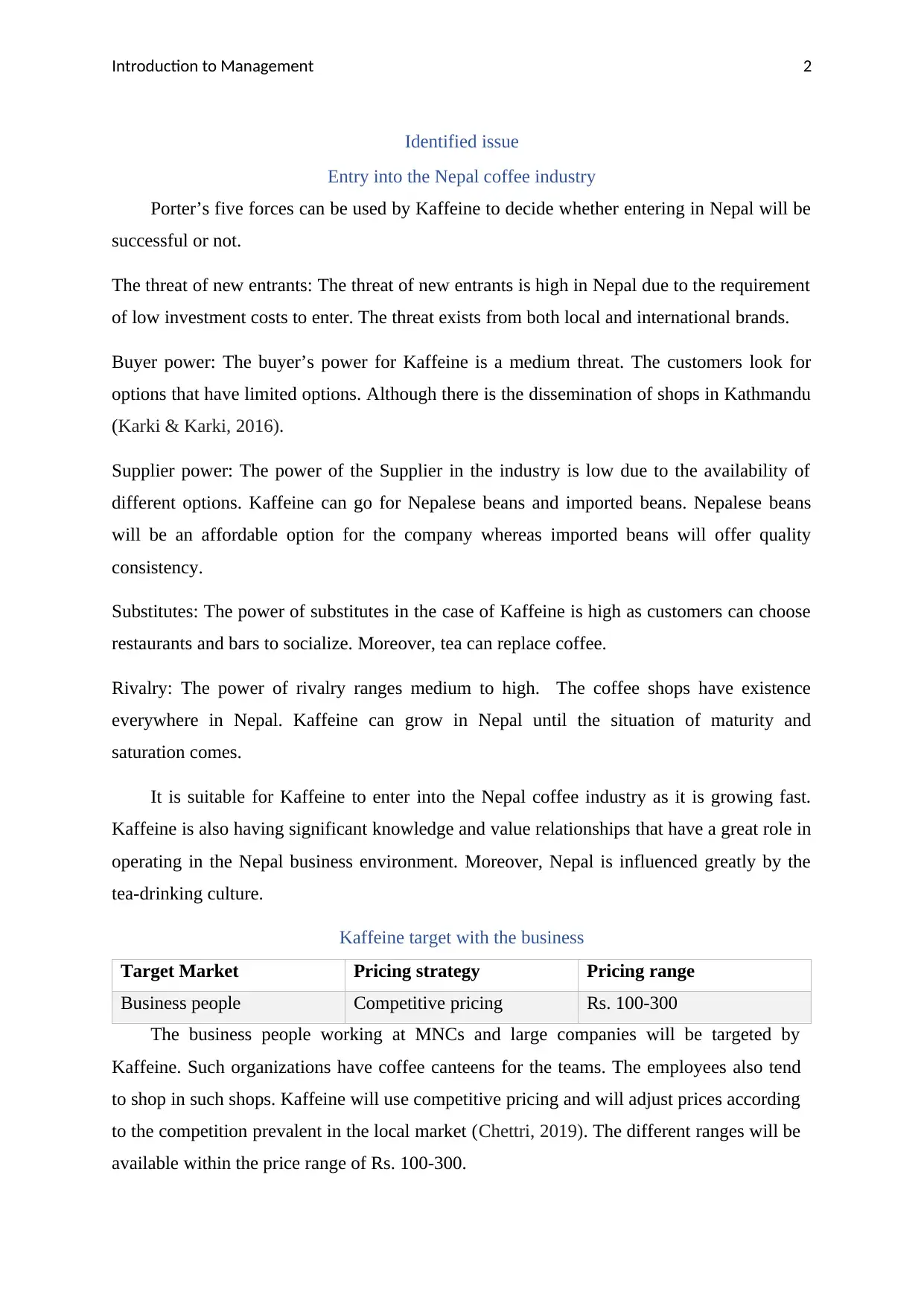
Introduction to Management 2
Identified issue
Entry into the Nepal coffee industry
Porter’s five forces can be used by Kaffeine to decide whether entering in Nepal will be
successful or not.
The threat of new entrants: The threat of new entrants is high in Nepal due to the requirement
of low investment costs to enter. The threat exists from both local and international brands.
Buyer power: The buyer’s power for Kaffeine is a medium threat. The customers look for
options that have limited options. Although there is the dissemination of shops in Kathmandu
(Karki & Karki, 2016).
Supplier power: The power of the Supplier in the industry is low due to the availability of
different options. Kaffeine can go for Nepalese beans and imported beans. Nepalese beans
will be an affordable option for the company whereas imported beans will offer quality
consistency.
Substitutes: The power of substitutes in the case of Kaffeine is high as customers can choose
restaurants and bars to socialize. Moreover, tea can replace coffee.
Rivalry: The power of rivalry ranges medium to high. The coffee shops have existence
everywhere in Nepal. Kaffeine can grow in Nepal until the situation of maturity and
saturation comes.
It is suitable for Kaffeine to enter into the Nepal coffee industry as it is growing fast.
Kaffeine is also having significant knowledge and value relationships that have a great role in
operating in the Nepal business environment. Moreover, Nepal is influenced greatly by the
tea-drinking culture.
Kaffeine target with the business
Target Market Pricing strategy Pricing range
Business people Competitive pricing Rs. 100-300
The business people working at MNCs and large companies will be targeted by
Kaffeine. Such organizations have coffee canteens for the teams. The employees also tend
to shop in such shops. Kaffeine will use competitive pricing and will adjust prices according
to the competition prevalent in the local market (Chettri, 2019). The different ranges will be
available within the price range of Rs. 100-300.
Identified issue
Entry into the Nepal coffee industry
Porter’s five forces can be used by Kaffeine to decide whether entering in Nepal will be
successful or not.
The threat of new entrants: The threat of new entrants is high in Nepal due to the requirement
of low investment costs to enter. The threat exists from both local and international brands.
Buyer power: The buyer’s power for Kaffeine is a medium threat. The customers look for
options that have limited options. Although there is the dissemination of shops in Kathmandu
(Karki & Karki, 2016).
Supplier power: The power of the Supplier in the industry is low due to the availability of
different options. Kaffeine can go for Nepalese beans and imported beans. Nepalese beans
will be an affordable option for the company whereas imported beans will offer quality
consistency.
Substitutes: The power of substitutes in the case of Kaffeine is high as customers can choose
restaurants and bars to socialize. Moreover, tea can replace coffee.
Rivalry: The power of rivalry ranges medium to high. The coffee shops have existence
everywhere in Nepal. Kaffeine can grow in Nepal until the situation of maturity and
saturation comes.
It is suitable for Kaffeine to enter into the Nepal coffee industry as it is growing fast.
Kaffeine is also having significant knowledge and value relationships that have a great role in
operating in the Nepal business environment. Moreover, Nepal is influenced greatly by the
tea-drinking culture.
Kaffeine target with the business
Target Market Pricing strategy Pricing range
Business people Competitive pricing Rs. 100-300
The business people working at MNCs and large companies will be targeted by
Kaffeine. Such organizations have coffee canteens for the teams. The employees also tend
to shop in such shops. Kaffeine will use competitive pricing and will adjust prices according
to the competition prevalent in the local market (Chettri, 2019). The different ranges will be
available within the price range of Rs. 100-300.
⊘ This is a preview!⊘
Do you want full access?
Subscribe today to unlock all pages.

Trusted by 1+ million students worldwide
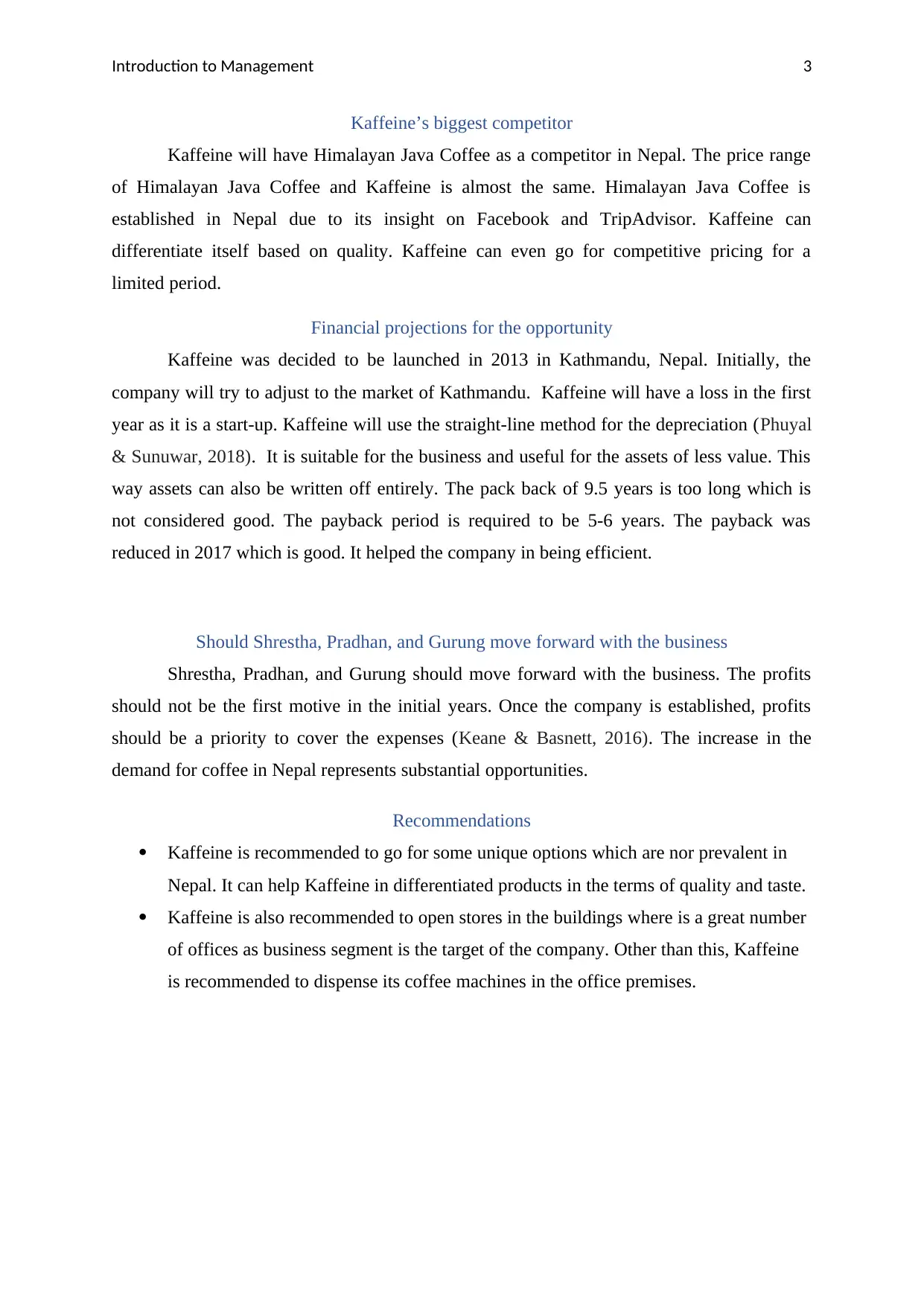
Introduction to Management 3
Kaffeine’s biggest competitor
Kaffeine will have Himalayan Java Coffee as a competitor in Nepal. The price range
of Himalayan Java Coffee and Kaffeine is almost the same. Himalayan Java Coffee is
established in Nepal due to its insight on Facebook and TripAdvisor. Kaffeine can
differentiate itself based on quality. Kaffeine can even go for competitive pricing for a
limited period.
Financial projections for the opportunity
Kaffeine was decided to be launched in 2013 in Kathmandu, Nepal. Initially, the
company will try to adjust to the market of Kathmandu. Kaffeine will have a loss in the first
year as it is a start-up. Kaffeine will use the straight-line method for the depreciation (Phuyal
& Sunuwar, 2018). It is suitable for the business and useful for the assets of less value. This
way assets can also be written off entirely. The pack back of 9.5 years is too long which is
not considered good. The payback period is required to be 5-6 years. The payback was
reduced in 2017 which is good. It helped the company in being efficient.
Should Shrestha, Pradhan, and Gurung move forward with the business
Shrestha, Pradhan, and Gurung should move forward with the business. The profits
should not be the first motive in the initial years. Once the company is established, profits
should be a priority to cover the expenses (Keane & Basnett, 2016). The increase in the
demand for coffee in Nepal represents substantial opportunities.
Recommendations
Kaffeine is recommended to go for some unique options which are nor prevalent in
Nepal. It can help Kaffeine in differentiated products in the terms of quality and taste.
Kaffeine is also recommended to open stores in the buildings where is a great number
of offices as business segment is the target of the company. Other than this, Kaffeine
is recommended to dispense its coffee machines in the office premises.
Kaffeine’s biggest competitor
Kaffeine will have Himalayan Java Coffee as a competitor in Nepal. The price range
of Himalayan Java Coffee and Kaffeine is almost the same. Himalayan Java Coffee is
established in Nepal due to its insight on Facebook and TripAdvisor. Kaffeine can
differentiate itself based on quality. Kaffeine can even go for competitive pricing for a
limited period.
Financial projections for the opportunity
Kaffeine was decided to be launched in 2013 in Kathmandu, Nepal. Initially, the
company will try to adjust to the market of Kathmandu. Kaffeine will have a loss in the first
year as it is a start-up. Kaffeine will use the straight-line method for the depreciation (Phuyal
& Sunuwar, 2018). It is suitable for the business and useful for the assets of less value. This
way assets can also be written off entirely. The pack back of 9.5 years is too long which is
not considered good. The payback period is required to be 5-6 years. The payback was
reduced in 2017 which is good. It helped the company in being efficient.
Should Shrestha, Pradhan, and Gurung move forward with the business
Shrestha, Pradhan, and Gurung should move forward with the business. The profits
should not be the first motive in the initial years. Once the company is established, profits
should be a priority to cover the expenses (Keane & Basnett, 2016). The increase in the
demand for coffee in Nepal represents substantial opportunities.
Recommendations
Kaffeine is recommended to go for some unique options which are nor prevalent in
Nepal. It can help Kaffeine in differentiated products in the terms of quality and taste.
Kaffeine is also recommended to open stores in the buildings where is a great number
of offices as business segment is the target of the company. Other than this, Kaffeine
is recommended to dispense its coffee machines in the office premises.
Paraphrase This Document
Need a fresh take? Get an instant paraphrase of this document with our AI Paraphraser
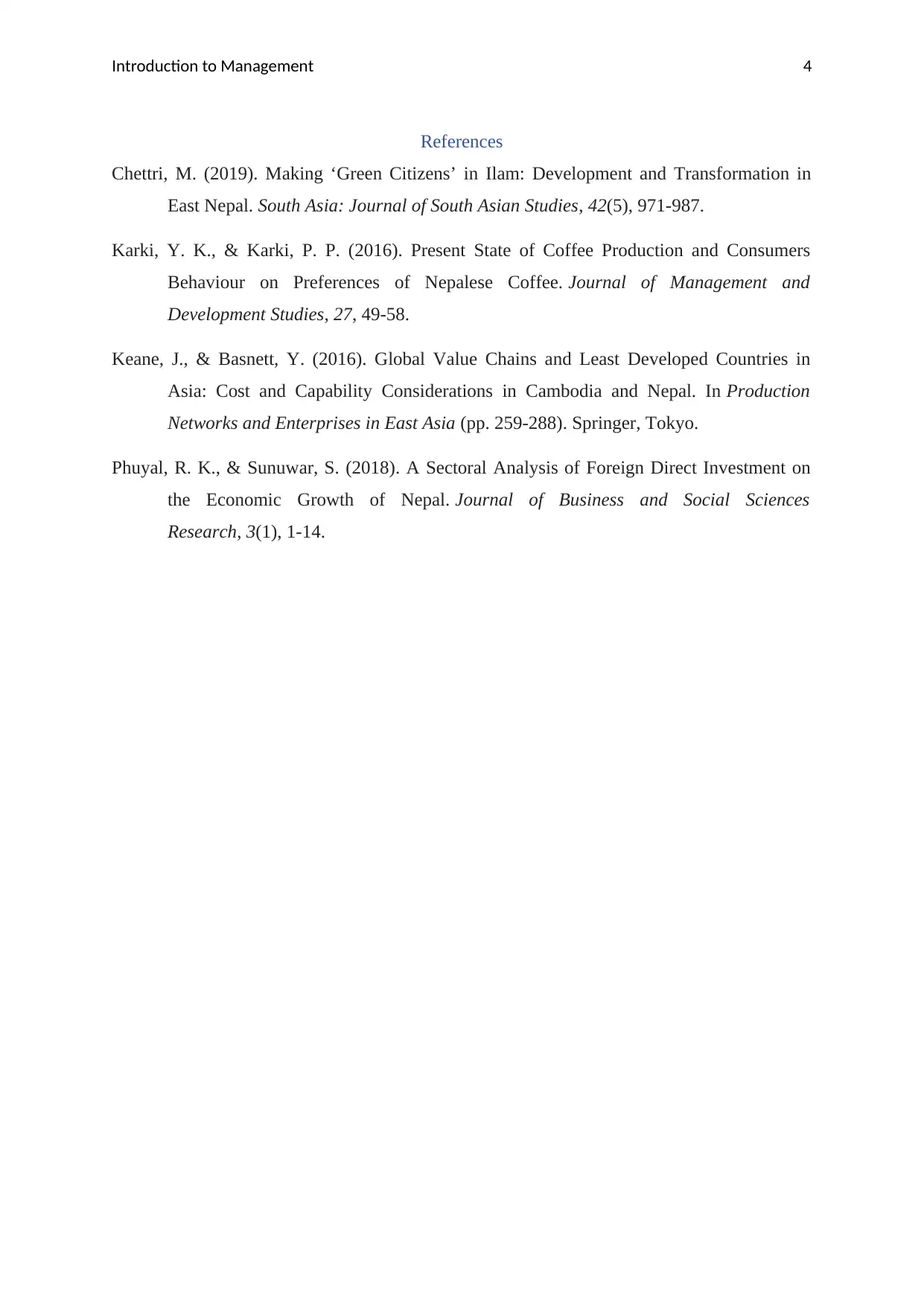
Introduction to Management 4
References
Chettri, M. (2019). Making ‘Green Citizens’ in Ilam: Development and Transformation in
East Nepal. South Asia: Journal of South Asian Studies, 42(5), 971-987.
Karki, Y. K., & Karki, P. P. (2016). Present State of Coffee Production and Consumers
Behaviour on Preferences of Nepalese Coffee. Journal of Management and
Development Studies, 27, 49-58.
Keane, J., & Basnett, Y. (2016). Global Value Chains and Least Developed Countries in
Asia: Cost and Capability Considerations in Cambodia and Nepal. In Production
Networks and Enterprises in East Asia (pp. 259-288). Springer, Tokyo.
Phuyal, R. K., & Sunuwar, S. (2018). A Sectoral Analysis of Foreign Direct Investment on
the Economic Growth of Nepal. Journal of Business and Social Sciences
Research, 3(1), 1-14.
References
Chettri, M. (2019). Making ‘Green Citizens’ in Ilam: Development and Transformation in
East Nepal. South Asia: Journal of South Asian Studies, 42(5), 971-987.
Karki, Y. K., & Karki, P. P. (2016). Present State of Coffee Production and Consumers
Behaviour on Preferences of Nepalese Coffee. Journal of Management and
Development Studies, 27, 49-58.
Keane, J., & Basnett, Y. (2016). Global Value Chains and Least Developed Countries in
Asia: Cost and Capability Considerations in Cambodia and Nepal. In Production
Networks and Enterprises in East Asia (pp. 259-288). Springer, Tokyo.
Phuyal, R. K., & Sunuwar, S. (2018). A Sectoral Analysis of Foreign Direct Investment on
the Economic Growth of Nepal. Journal of Business and Social Sciences
Research, 3(1), 1-14.
1 out of 5
Your All-in-One AI-Powered Toolkit for Academic Success.
+13062052269
info@desklib.com
Available 24*7 on WhatsApp / Email
![[object Object]](/_next/static/media/star-bottom.7253800d.svg)
Unlock your academic potential
Copyright © 2020–2025 A2Z Services. All Rights Reserved. Developed and managed by ZUCOL.

